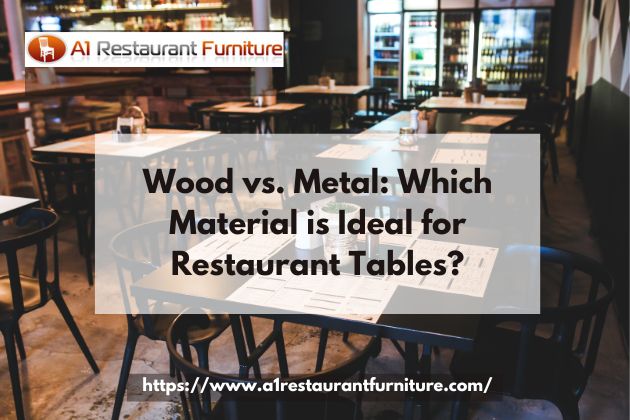Wood vs. Metal: Which Material is Ideal for Restaurant Tables?

Introduction
When it comes to choosing the right material for restaurant tables, the decision often boils down to wood or metal. Both materials offer unique advantages and considerations that restaurant owners must take into account. In this article, we will compare wood and metal as materials for restaurant tables and explore their characteristics, durability, aesthetics, maintenance requirements, and other relevant factors. By the end, you'll have a better understanding of which material is ideal for your restaurant tables.
Durability
Wood
Wooden tables possess an everlasting charm and have the ability to establish a cozy and welcoming ambiance within a restaurant setting. Nonetheless, the longevity of wood is contingent upon the specific type of wood employed. Hardwoods such as oak and maple exhibit enhanced resistance against scratches, dents, and overall wear and tear. They have the capacity to endure substantial usage and are less susceptible to warping or splitting over time. Conversely, softwoods like pine are more vulnerable to damage and necessitate more frequent upkeep.
Metal
Metal tables are renowned for their durability, especially when crafted from stainless steel or aluminum. These materials bestow upon them the remarkable ability to resist scratches, stains, and heat. With their robust construction, metal tables can endure extensive use and are less prone to warping or cracking in comparison to their wooden counterparts. However, it's important to note that if not given proper care, metal tables may be vulnerable to dents.
Metal tables, particularly those fabricated from stainless steel or aluminum, possess outstanding durability. They exhibit resistance against scratches, stains, and heat, making them highly reliable for everyday use. Unlike wooden tables, metal tables maintain their structural integrity and are less prone to deformities. Nevertheless, it's essential to handle them with care to avoid any potential dents.
Aesthetics
Wood
Wooden tables offer a natural and rustic charm that many restaurants find appealing. The grains, patterns, and colors of different wood species can add character and warmth to the dining space. Wood tables can be customized with various finishes, stains, or paints to match the restaurant's interior design.
Metal
Metal tables possess a distinct appeal, often emanating a modern and sleek aura that seamlessly complements contemporary or industrial-themed restaurants. These tables come in an array of finishes, ranging from brushed, polished, to powder-coated, allowing for customization based on individual preferences. With a wide variety of shapes and designs to choose from, metal tables offer exceptional versatility, accommodating diverse styles and aesthetic choices.
Maintenance
Wood
To keep wood tables in optimal condition, consistent maintenance is essential. Cleaning them with a gentle detergent and a soft cloth is advised to effectively eliminate spills and stains. Regular resealing or refinishing might be required to safeguard the wood against moisture and preserve its visual appeal. Furthermore, periodic polishing can be beneficial in revitalizing the table's luster and shine.
Metal
Metal tables are generally low-maintenance and easy to clean. They can be wiped down with a damp cloth and mild detergent to remove dirt or spills. Metal tables are less prone to staining and do not require sealing or refinishing. However, certain metal finishes may show fingerprints or scratches more prominently.
Weight and Mobility
Wood
Wooden tables are generally heavier than their metal counterparts. While this can contribute to their sturdiness, it may also make them more challenging to move or rearrange within the restaurant space. However, the weight of wood can provide stability and reduce the risk of tables tipping over.
Metal
Metal tables offer the benefit of being lighter in weight when compared to their wooden counterparts, resulting in easier maneuverability. This feature proves advantageous for restaurant owners who frequently rearrange their seating arrangements or need to accommodate larger groups. The lightweight nature of metal tables also simplifies the cleaning process, making it more convenient and efficient for maintenance staff.
Conclusion
In the debate of wood vs. metal for restaurant tables, there is no definitive winner. The choice ultimately depends on the specific needs and preferences of each restaurant. Wood offers a classic and warm aesthetic with customizable options, but it requires more maintenance. Metal, on the other hand, provides durability, modern appeal, and ease of maintenance. Consider factors such as the restaurant's theme, atmosphere, customer preferences, and budget when deciding which material is ideal for your restaurant tables.
FAQs (Frequently Asked Questions)
Are wood tables more expensive than metal tables?
Wood tables can vary in price depending on the type of wood used, craftsmanship, and customization options. Generally, high-quality wood tables may be more expensive than metal tables, but there are affordable wood options available as well.
Do metal tables rust over time?
Stainless steel and aluminum, commonly used metals for restaurant tables, are resistant to rust. With proper care and maintenance, metal tables can remain rust-free for a long time.
Can wood tables be used outdoors?
While certain types of wood like teak or cedar are suitable for outdoor use, most wood tables are designed for indoor environments. Exposure to moisture and sunlight can damage wood and reduce its lifespan.
Which material is more eco-friendly?
Both wood and metal can be eco-friendly depending on their sourcing and production methods. Look for sustainable certifications or reclaimed wood options if environmental concerns are a priority.
Can I mix wood and metal tables in my restaurant?
Absolutely! Mixing wood and metal tables can create an interesting and dynamic dining space. It allows you to play with contrasting textures and styles while accommodating different seating arrangements.









